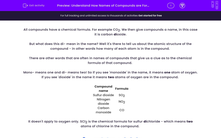All compounds have a chemical formula. For example CO2. We then give compounds a name, in this case it is carbon dioxide.
But what does this di- mean in the name? Well it's there to tell us about the atomic structure of the compound - in other words how many of each atom is in the compound.
There are other words that are often in names of compounds that give us a clue as to the chemical formula of that compound.
Mono- means one and di- means two! So if you see 'monoxide' in the name, it means one atom of oxygen. If you see 'dioxide' in the name it means two atoms of oxygen are in the compound.
| Compound name | Formula |
| Sulfur dioxide | SO2 |
| Nitrogen dioxide | NO2 |
| Carbon monoxide | CO |
It doesn't apply to oxygen only. SCl2 is the chemical formula for sulfur dichloride - which means two atoms of chlorine in the compound.

Compounds called hydrocarbons, such as alkanes and alkenes, also have repetitive names - and the start of the name can tell you about the chemical formula of the compound - specifically the number of carbon atoms in the molecule. Meth = 1, Eth = 2, Hex = 6 etc
| Name of alkane | Formula |
|
Meth-ane Eth-ane Prop-ane But-ane Pent-ane Hex-ane |
CH4 C2H6 C3H8 C4H10 C5H12 C6H14 |
Let's have a go at seeing if you can recognise and name some of these common, but more tricky compounds. You may like to have a copy of the periodic table handy.
.jpg)







